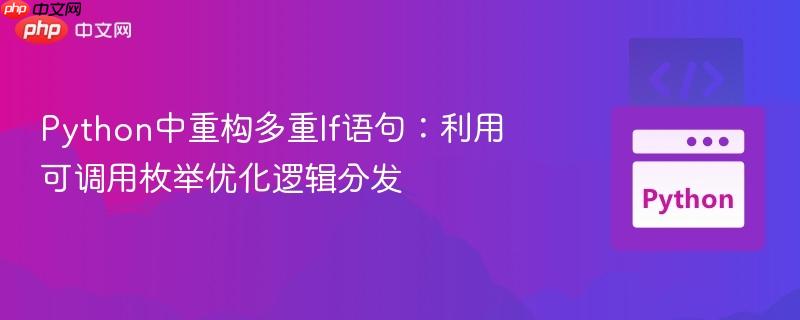
在处理基于固定选项(如枚举)进行条件逻辑分发时,常见的多重`if`语句链会使代码冗余且难以维护。本文将介绍一种利用python的`textchoices`(或其他自定义枚举)的`__call__`方法来封装业务逻辑的策略,从而消除冗长的`if`判断,实现更简洁、可扩展且符合开闭原则的代码结构。
冗余If语句的问题与挑战
在软件开发中,我们经常遇到需要根据某个输入值执行不同操作的场景。当这些输入值是预定义的一组常量或枚举成员时,一种直观但效率低下的做法是使用一系列if-elif-else或独立的if语句来判断并分发逻辑。
考虑以下一个典型的python Django REST Framework视图示例,它根据请求参数中的fields列表来计算并返回不同类型的计数:
from rest_framework.response import Response from django.db.models import TextChoices class CounterFilters(TextChoices): publications_total = "publications-total" publications_free = "publications-free" publications_paid = "publications-paid" comments_total = "comments-total" votes_total = "voted-total" class SomeView: def get(self, request, format=None): user = request.user response_data = [] if "fields" in request.query_params: fields = request.GET.getlist("fields") for field in fields: if field == CounterFilters.publications_total: response_data.append({"type": CounterFilters.publications_total, "count": "some_calculations1"}) if field == CounterFilters.publications_free: response_data.append({"type": CounterFilters.publications_free, "count": "some_calculations2"}) if field == CounterFilters.publications_paid: response_data.append({"type": CounterFilters.publications_paid, "count": "some_calculations3"}) if field == CounterFilters.comments_total: response_data.append({"type": CounterFilters.comments_total, "count": "some_calculations4"}) if field == CounterFilters.votes_total: response_data.append({"type": CounterFilters.votes_total, "count": "some_calculations5"}) return Response(response_data)
上述代码存在以下问题:
- 代码重复与冗余: 每个if块的结构非常相似,导致大量重复代码。
- 可维护性差: 当需要添加新的计数类型时,必须修改SomeView中的get方法,违反了开闭原则(对扩展开放,对修改封闭)。
- 可读性差: 随着条件增多,if语句链会变得非常长,难以快速理解其意图。
优化方案:利用可调用枚举封装逻辑
为了解决上述问题,我们可以将与每个CounterFilters成员相关的计算逻辑直接封装到CounterFilters类中,并使其成员成为可调用的对象。Python类的__call__方法允许一个实例像函数一样被调用。结合getattr,我们可以根据枚举成员的名称动态地调用对应的方法。
立即学习“Python免费学习笔记(深入)”;
1. 改造CounterFilters枚举类
首先,修改CounterFilters类,添加一个__call__方法和一系列以get_开头的具体计算方法:
from django.db.models import TextChoices class CounterFilters(TextChoices): publications_total = 'publications-total' publications_free = 'publications-free' publications_paid = 'publications-paid' comments_total = 'comments-total' votes_total = 'voted-total' def __call__(self, request): """ 使枚举成员可调用,并动态分发到对应的get_方法。 """ # 动态构建方法名,例如 'get_publications_total' method_name = f'get_{self.name}' # 使用getattr获取并调用对应的方法 return getattr(self, method_name)(request) def get_publications_total(self, request): # 实际的计算逻辑,可能依赖于request或其他上下文 return 42 def get_publications_free(self, request): return 14 def get_publications_paid(self, request): return 25 def get_comments_total(self, request): return 1337 def get_votes_total(self, request): return 1207
关键点解析:
- __call__(self, request): 这个特殊方法使得CounterFilters.publications_total这样的枚举成员在被实例化后可以直接像函数一样被调用,例如 _filter(request)。
- getattr(self, f’get_{self.name}’): self.name会返回枚举成员的名称(例如’publications_total’)。通过f’get_{self.name}’,我们构建出期望调用的方法名(例如’get_publications_total’)。getattr函数则根据这个名称从self(即CounterFilters的实例)中获取对应的方法对象。
- (request): 获取到方法对象后,我们立即调用它,并将request对象作为参数传递进去。这样,每个具体的计算方法可以根据需要访问请求信息。
2. 简化SomeView视图逻辑
经过上述改造,SomeView中的get方法将变得异常简洁,不再需要任何if语句来分发逻辑:
from rest_framework.response import Response # 假设 CounterFilters 已经定义在可访问的模块中 class SomeView: def get(self, request, format=None): user = request.user # user信息可能在计算中使用 response_data = [] if "fields" in request.query_params: fields = request.GET.getlist('fields') for field_value in fields: try: # 尝试将查询参数值转换为CounterFilters枚举成员 _filter = CounterFilters(field_value) except ValueError: # 如果field_value不是有效的CounterFilters成员,则跳过 # 也可以选择记录错误或返回错误信息 continue else: # 直接调用枚举成员,它会自动执行对应的计算方法 count_value = _filter(request) response_data.append( {'type': field_value, 'count': count_value} ) return Response(response_data)
关键点解析:
- _filter = CounterFilters(field_value): 通过传入字符串值,TextChoices会自动尝试匹配并返回对应的枚举成员实例。如果field_value不是有效的枚举值,将抛出ValueError。
- try…except ValueError: 这是为了健壮性考虑。如果请求中包含无效的field参数,代码不会崩溃,而是优雅地跳过该无效项。
- _filter(request): 这是核心所在。之前在CounterFilters中定义的__call__方法使得这个枚举成员实例可以直接被调用,并自动分发到正确的get_方法来执行计算。
这种优化方案的优势
- 消除冗余If语句: 彻底移除了视图中的多重if判断,代码更加简洁。
- 提高可维护性与可扩展性: 当需要添加新的计数类型时,只需在CounterFilters中添加一个新的枚举成员和对应的get_方法,无需修改SomeView中的现有逻辑。这完美符合开闭原则。
- 封装性增强: 将每种计数类型的具体计算逻辑封装在CounterFilters类内部,使得逻辑更加内聚,职责划分更清晰。
- 提高可读性: 视图层代码只负责参数解析和结果聚合,核心业务逻辑的细节被抽象到枚举类中,提高了代码的可读性。
注意事项与扩展
- 参数传递: __call__方法可以接受任意数量和类型的参数,你可以根据实际需要调整get_方法的签名。例如,如果计算需要user对象,可以将user作为参数传递给_filter(request, user)。
- 错误处理: try…except ValueError是处理无效输入的基础方式。在实际应用中,你可能需要更复杂的错误报告机制。
- 复杂逻辑: 对于非常复杂的业务逻辑,除了直接在枚举中定义方法外,也可以考虑结合策略模式或命令模式,将每个get_方法委托给一个独立的策略或命令对象,以进一步解耦。
- 其他枚举类型: 这种模式不仅适用于Django的TextChoices,也适用于Python标准库的enum.Enum或enum.IntEnum等自定义枚举类型。
总结
通过将与枚举成员相关的特定逻辑封装到枚举类自身的__call__方法中,并利用getattr进行动态方法分发,我们可以有效地消除视图或其他业务逻辑层中冗长的多重if语句。这种模式不仅使代码更加简洁、可读,还显著提升了系统的可维护性和可扩展性,是处理基于固定选项进行逻辑分发时的一种优雅且专业的解决方案。


